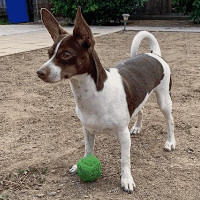Appearance of the Toy Rat Doxie
|
| Given the various genetic influences they have accumulated over time, the only universal attributes of most Toy Rat Doxies are that they are relatively short and light, with more length than height, with a maximum height of around 46 centimeters and only 16 kilos. Most of them also have a longer muzzle, a slightly curved medium tail and a muscular but athletic build that runs the length of their elongated body. Coat length varies from short to medium, and can be straight, wiry or wavy. Colors range from white to red, brown and black, often with a combination of two or more colors. |
Temperament of the Toy Rat Doxie
|
| While the Dachshund is known for being stubborn, noisy and generally independent, the Rat Terrier is obedient, eager to please and quite affectionate, making the Toy Rat Doxie a mild-mannered dog with a good general temperament and only occasional problems, such as frequent barking, which can usually be resolved with a little training. They are incredibly intelligent, but without direction, their intelligence and curiosity can sometimes turn into mischievous behavior, so it's important to give them an adequate amount of attention and play/activity time. So it's important to give him enough attention and time to play and have fun. |
Needs and activities of the Toy Rat Doxie
|
| The Toy Rat Doxie has a moderate to above-average activity level, which means owners need to allow it regular exercise. As they are highly intelligent and have a hunting instinct, creative games that make them run, think or both are particularly rewarding and help prevent mischievous behavior, 45 to 60 minutes a day should suffice. |
Maintenance of the Toy Rat Doxie
|
| On the whole, Toy Rat Doxies need little grooming as their generally short coats are not prone to abnormal shedding, and a weekly brushing should suffice. Their nails are notoriously fast-growing, so owners should trim them regularly to prevent splitting. Dental problems are also semi-common, so regular brushing and dental check-ups will keep their mouths healthy and prevent any future problems. Ear cleaning and care are more often reserved for dogs whose lineage has highlighted the soft, pendulous ear type, as they are more prone to infections. Although these are generally resilient dogs that can live in a variety of environments, they often require outdoor jackets in colder climates. Owners should also be aware that, due to their elongated silhouette, Toy Rat Doxies can be prone to spinal problems, so excessive use of stairs or areas requiring frequent jumping can become problematic over time. These scenarios can easily be resolved with ramps or by lifting the dog and remembering to support both ends. |









 English (United Kingdom)
English (United Kingdom)